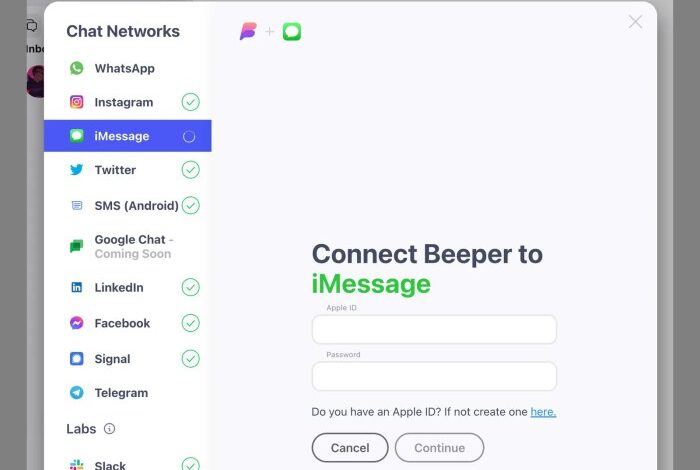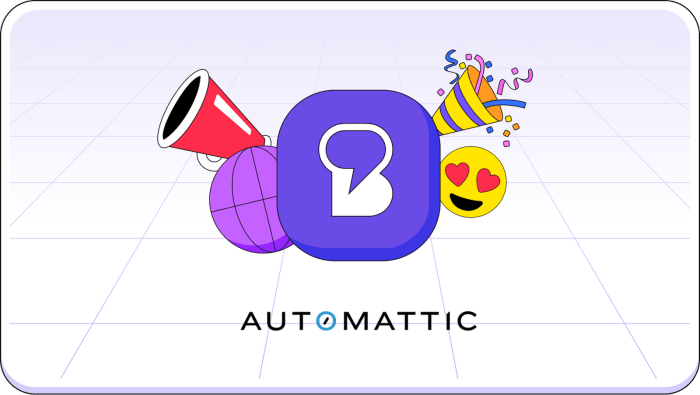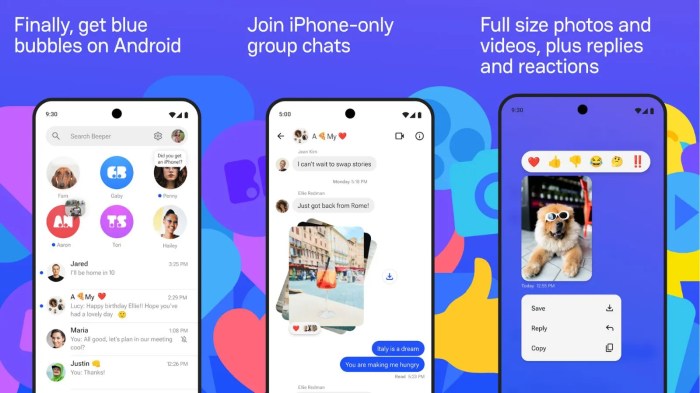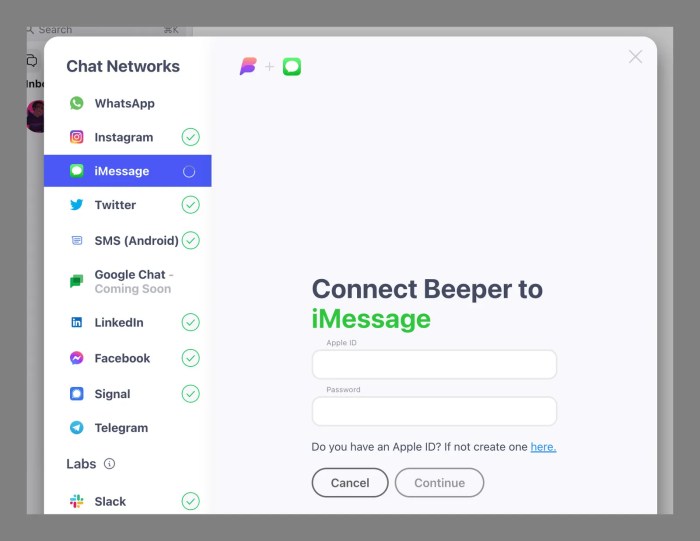
Beepers Back, But Apples Still King
iMessage on Android app Beeper is back with a new owner but its given up on fighting Apple for now. Remember Beeper? The app that promised to bring iMessage to Android? Well, it’s back, but with a new owner and a different strategy.
Instead of directly challenging Apple, Beeper is now focusing on being a unified messaging platform that supports a wide range of services, including iMessage, WhatsApp, Signal, and more. This shift in strategy is interesting, and it raises some questions about the future of cross-platform messaging.
The original vision of Beeper was to make iMessage available to Android users by using a clever workaround. However, Apple’s tight control over iMessage made it difficult for Beeper to compete. The app faced technical challenges and legal hurdles, and it ultimately failed to achieve widespread adoption.
Now, Beeper is taking a different approach, focusing on becoming a one-stop shop for all your messaging needs. This strategy is more realistic, and it could potentially attract a larger audience.
Beeper’s Return and New Ownership
Beeper, the app that aimed to offer a unified messaging experience across platforms, is back after a period of uncertainty. The app, once known for its bold attempt to challenge Apple’s iMessage dominance, has returned under new ownership and with a revised approach.
While Beeper has abandoned its previous ambition to directly compete with Apple, its return signifies a renewed focus on providing a comprehensive messaging solution for users.
The History of Beeper and Its Attempts to Challenge Apple
Beeper’s journey has been marked by its ambition to offer a truly cross-platform messaging experience, a feat that has proven difficult due to Apple’s closed ecosystem and iMessage’s popularity. Beeper’s previous efforts to challenge Apple’s dominance were centered around building a messaging app that could connect users across different platforms, including Android, iOS, and desktop operating systems.
However, these efforts were met with significant challenges, primarily due to Apple’s control over iMessage and its reluctance to allow third-party apps to access its messaging platform.
It’s interesting to see Beeper, the iMessage app for Android, back with a new owner. They’ve seemingly accepted the reality of Apple’s walled garden and are focusing on other areas. Perhaps this is a sign of the times – the constant battle for interoperability is shifting focus.
It’s a similar story in the email world, where the debate between Microsoft Outlook and Apple Mail continues. Ultimately, the best email client for business depends on individual needs and priorities. But it’s clear that the fight for universal compatibility, as seen with Beeper, might be losing steam.
The Significance of Beeper’s New Ownership
Beeper’s return under new ownership marks a significant shift in the app’s trajectory. The new owners, a group of investors with a strong track record in technology and innovation, bring a fresh perspective and resources to the project. This new ownership structure suggests a renewed commitment to developing and improving Beeper, potentially leading to exciting new features and advancements.
Beeper’s Decision to Step Back from Direct Competition with Apple
Beeper’s decision to step back from directly competing with Apple reflects a pragmatic approach to achieving its goals. The app’s developers have acknowledged the significant challenges posed by Apple’s closed ecosystem and iMessage’s widespread adoption. Instead of pursuing a head-on confrontation, Beeper has opted to focus on building a comprehensive messaging solution that caters to the needs of users who value cross-platform compatibility and privacy.
This strategic shift aims to carve out a niche for Beeper in the messaging market, attracting users who are looking for a more open and versatile platform.
Beeper’s Current Focus and Strategy

Beeper, the messaging app that aims to unify communication across platforms, has undergone a significant transformation with its new ownership. While the app’s ambitions to directly challenge Apple’s messaging ecosystem have been shelved, Beeper has shifted its focus to becoming a robust and reliable platform for cross-platform communication.
This strategy involves leveraging its unique features and functionalities to cater to a specific target audience with particular communication needs.
Beeper’s Core Features and Functionality
Beeper’s primary goal is to provide a seamless and unified messaging experience across various platforms. The app achieves this by acting as a central hub for different messaging services, including iMessage, WhatsApp, Telegram, Signal, and more. This approach offers several advantages, including:
- Unified Inbox:Beeper consolidates all your messages from different platforms into a single inbox, eliminating the need to switch between multiple apps.
- Cross-Platform Compatibility:Beeper allows you to communicate with people using different messaging services without requiring them to install the app. This feature makes it a valuable tool for individuals who frequently communicate with people using different platforms.
- End-to-End Encryption:Beeper supports end-to-end encryption for supported services, ensuring the privacy and security of your communications.
- Advanced Features:Beeper offers additional features like group chats, file sharing, and message scheduling, enhancing its functionality beyond basic messaging.
However, Beeper also faces some challenges, including:
- Dependence on Third-Party Services:Beeper’s functionality relies on the availability and stability of third-party messaging services. Any changes or disruptions in these services could affect Beeper’s performance.
- Limited Reach:While Beeper offers compatibility with a wide range of messaging platforms, it may not be as widely used as standalone messaging apps, potentially limiting its reach and user base.
- User Interface:Some users have reported that Beeper’s user interface can be complex and less intuitive compared to dedicated messaging apps.
Beeper’s Differentiation and Target Audience
Beeper distinguishes itself from other messaging apps by focusing on unifying communication across multiple platforms. Unlike apps like WhatsApp or Telegram, which aim to establish a single dominant messaging ecosystem, Beeper embraces the existing landscape of messaging services. This approach makes Beeper a unique solution for individuals and organizations that need to communicate seamlessly across various platforms.
Beeper’s target audience includes:
- Individuals with diverse communication needs:People who frequently communicate with friends, family, and colleagues using different messaging services will find Beeper’s unified inbox and cross-platform compatibility particularly beneficial.
- Businesses and organizations:Beeper can be a valuable tool for businesses that need to communicate with clients and partners using various messaging platforms. The app’s unified interface and cross-platform compatibility can streamline communication and improve efficiency.
- Tech-savvy users:Beeper’s advanced features and customization options appeal to tech-savvy users who appreciate flexibility and control over their messaging experience.
The Future of Cross-Platform Messaging

The dream of a truly unified messaging experience, where you can seamlessly connect with anyone regardless of their device or platform, remains elusive. While various solutions have emerged, none have completely cracked the code. The current landscape presents a complex mix of strengths and limitations, highlighting the challenges and opportunities for companies like Beeper in their quest for a universal messaging platform.
So, Beeper, the iMessage app for Android, is back with a new owner, but they’ve decided to stop fighting Apple for now. It’s probably a wise move considering the price tag of Apple’s new Vision Pro headset – apple vision pro financing starts at dollar291 a month over 12 months – which makes it clear that Apple is still very much in control of its ecosystem.
Maybe Beeper will focus on other messaging features, or maybe they’ll just wait for Apple to make a move on interoperability. Either way, it’s a reminder that sometimes the best strategy is to pick your battles.
Current State of Cross-Platform Messaging Solutions
Several approaches to cross-platform messaging exist, each with its strengths and weaknesses:
- Proprietary Messaging Apps:Giants like WhatsApp, Messenger, and iMessage dominate the market with their vast user bases. They offer seamless communication within their ecosystems but fall short of true interoperability. Users often need multiple accounts, creating fragmentation and limiting communication possibilities.
- Unified Messaging Platforms:Platforms like Beeper aim to bridge the gap by offering a unified interface for various messaging services. While they offer a single point of access, they rely on underlying protocols and integrations that can be complex and susceptible to changes in the platforms they connect to.
It’s interesting to see Beeper back in the game with a new owner, but their decision to abandon the fight with Apple for iMessage on Android seems like a strategic shift. Perhaps they’re focusing on other areas, like security, as evidenced by the recent discovery of the XLoader malware variant targeting macOS disguised as the “OfficeNote” app.
This kind of threat underscores the importance of secure messaging platforms, and Beeper’s future may hinge on how well they address these concerns.
- Open Standards:Open standards like Matrix and XMPP provide a framework for decentralized communication. They promote interoperability but lack the widespread adoption of proprietary solutions, leading to limited user bases and potentially hindering user experience.
Challenges and Opportunities for Companies Like Beeper
Companies like Beeper face significant hurdles in their pursuit of a unified messaging experience:
- Platform Dependence:Their success relies heavily on the cooperation and integration of other messaging platforms, which are often proprietary and controlled by large corporations. Maintaining compatibility and securing access can be challenging.
- Security and Privacy:Integrating different messaging services raises concerns about data security and privacy. Ensuring secure communication across platforms requires robust encryption and privacy-focused design principles.
- User Adoption:Convincing users to switch from established messaging apps and embrace a new platform requires significant effort. Building a large user base is crucial for achieving the desired network effect.
The Potential Impact of WebRTC, Imessage on android app beeper is back with a new owner but its given up on fighting apple for now
WebRTC (Web Real-Time Communication) holds promise for revolutionizing cross-platform messaging. It allows for real-time communication directly between browsers, eliminating the need for servers and intermediaries. This has the potential to:
- Enhance Security and Privacy:Direct peer-to-peer communication can reduce reliance on third-party servers, enhancing security and privacy.
- Enable Real-Time Collaboration:WebRTC can facilitate real-time collaboration features like shared editing and video conferencing within messaging applications.
- Reduce Infrastructure Costs:By eliminating the need for centralized servers, WebRTC can reduce infrastructure costs for messaging platforms.
Apple’s Dominance in Messaging

Apple’s dominance in the messaging market, particularly with iMessage, is a testament to the company’s strategic approach to integrating its services and creating a tightly controlled ecosystem. This dominance stems from a combination of factors, including the seamless integration of iMessage with other Apple devices, its user-friendly interface, and its focus on privacy and security.
The Advantages of iMessage
The competitive advantages offered by iMessage are numerous and contribute significantly to its widespread adoption. These advantages include:
- Seamless Integration with Apple Devices:iMessage is deeply integrated with Apple’s ecosystem, seamlessly working across iPhones, iPads, Macs, and Apple Watches. This integration allows for a consistent and unified messaging experience across all Apple devices.
- Rich Features:iMessage boasts a wide array of features, including:
- Group Messaging:Allows for easy communication with multiple people simultaneously.
- Reaction Emojis:Provides a quick and fun way to respond to messages.
- File Sharing:Enables users to share photos, videos, documents, and other files directly within the app.
- Read Receipts:Informs senders when their messages have been read, enhancing communication clarity.
- Typing Indicators:Show when someone is typing, providing a real-time indication of communication progress.
- Voice and Video Calls:Facilitates seamless communication through audio and video calls.
- User-Friendly Interface:iMessage’s intuitive interface makes it easy for users to navigate and use, even for those unfamiliar with messaging apps.
- Privacy and Security:Apple prioritizes privacy and security, ensuring that iMessage communications are end-to-end encrypted, meaning only the sender and receiver can access the content.
The Impact of iMessage on Cross-Platform Messaging
Apple’s iMessage ecosystem has a significant impact on the development and adoption of cross-platform messaging solutions. The seamless integration and features offered by iMessage create a strong incentive for Apple users to remain within the Apple ecosystem, making it challenging for cross-platform messaging apps to gain widespread adoption.
This is because:
- Apple Users Prefer iMessage:Apple users often prefer to communicate with other Apple users using iMessage due to its superior features and seamless integration.
- Limited Cross-Platform Compatibility:While some cross-platform messaging apps offer features similar to iMessage, they often lack the same level of integration and user experience, leading to a fragmented messaging experience.
- Green Bubbles:The distinctive green color of text messages sent to non-Apple users serves as a visual reminder of the limitations of cross-platform messaging, further reinforcing the preference for iMessage within the Apple ecosystem.
The Impact of Beeper’s Shift in Strategy: Imessage On Android App Beeper Is Back With A New Owner But Its Given Up On Fighting Apple For Now
Beeper’s recent decision to abandon its direct challenge to Apple’s messaging dominance and shift focus towards a more collaborative approach has significant implications for the cross-platform messaging landscape. This strategic pivot, while seemingly a concession to Apple’s stronghold, could have far-reaching consequences for the future of messaging and the players involved.
The Potential Impact on the Cross-Platform Messaging Landscape
Beeper’s shift in strategy could potentially reshape the cross-platform messaging landscape in several ways. By focusing on interoperability and collaboration, Beeper aims to create a more unified messaging ecosystem, potentially fostering greater adoption of its platform and driving innovation.
The Impact on Other Messaging App Developers
Beeper’s new approach could create opportunities for other messaging app developers to collaborate and integrate their platforms with Beeper’s network. This could lead to a more diverse and competitive ecosystem, potentially challenging Apple’s dominance in the messaging space. For instance, developers could leverage Beeper’s infrastructure to provide cross-platform messaging capabilities for their own apps, expanding their reach and user base.
The Potential Future of Beeper
Beeper’s new strategy positions it as a potential catalyst for cross-platform messaging innovation. By focusing on interoperability and collaboration, Beeper could become a central hub for messaging, facilitating communication between various platforms and services. This could lead to a more seamless and unified messaging experience for users, ultimately benefiting Beeper’s user base and attracting new users.
The Future of Cross-Platform Messaging
Beeper’s shift in strategy highlights the growing importance of cross-platform messaging. As users increasingly rely on multiple messaging platforms, the demand for seamless communication across different devices and services will continue to grow. Beeper’s focus on interoperability could contribute to a more unified and user-friendly messaging experience, potentially paving the way for a future where messaging is truly cross-platform and seamless.


